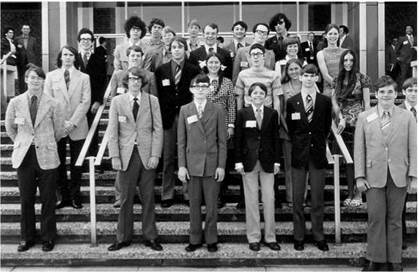Student Experiments
“The Skylab Student Program came into being because some of us involved in the space program were concerned over the decline in interest of our youth in science and engineering fields in ‘post-Apollo’ days, the first moon landings in 1969 having recently been made,” said Jack Waite, who served as the student experiment project coordinator while at Marshall Space Flight Center. “A number of NASA headquarters and field center personnel (msfc and msc, now jsc) discussed ways to stimulate the American youth interest in these fields. It became apparent that they could, even should, be an integral part of the Skylab Experiment Program. At headquarters Joe Lundholm was a key player, along with the program directors Bill Schneider and John Disher, Reg Machell at msc, and myself from msfc.”
Waite’s position as head of the Experiment Development and Integration Office at Marshall and also as a representative on the Manned Space Flight Experiment Board allowed him to facilitate this work over the next several years and to follow up the student careers for decades to follow.
The program developed was a nationwide contest for seventh – through twelfth-grade students and patterned very much like formal university spaceflight projects are selected. A “Request for Proposals” was sent to all fifty states and nine overseas high schools. These proposals were to be related to research experiments in seven basic areas of study: astronomy, botany, Earth observations, microbiology, physics, physiology, and zoology. The Marshall Skylab Experiments Office, which Waite headed, was designated to manage the student program. A total of 3,409 proposals were submitted and evaluated by the National Science Teachers Association, with participation from National Council for the Social Studies, NASA, and even Skylab flight crewmembers. From that total, twenty-five were selected as winners and twenty-two ended up being incorporated into the Skylab flight program, some carried out on each of the three missions. Most involved some modest hardware elements that were designed by the student principal investigators working with engineers at Marshall and structured as would be any professional program. Crew safety was always considered as well as
|
4.6. Students chosen to participate in the Skylab science program gather on the steps of Marshall Space Flight Center’s headquarters building. |
compatibility with all other experiments and systems. Design reviews and mission operations were reviewed, as were all other experiments by the Marshall Experiments Office.
The student program was and is considered a tremendous success. A yardstick for success should be the degree to which student interest and enthusiasm has carried over into career activities. While it is not possible to objectively measure the degree to which high-school students nationwide may have been moved to a better science and engineering awareness and career involvement, it is possible to follow most of these particular students, which Waite has done with great perseverance for decades. Among the twenty-two projects which ended up with approved and flown activities, the student Pis achieved careers as follows: six became science teachers (elementary, secondary, and university levels), seven were engineers and/or scientists, three became medical doctors, four had business careers, one was a military officer, and one became a monk. Many university advanced degrees are present in their biographies as well.
“Likely the most publicized experiment performed was the one proposed by Ms. Judith Miles from Lexington, Massachusetts, to observe how ‘Cross’ spiders spin their webs in space,” Waite said. “At our Skylab thirtieth anniversary celebration in 2003, we were pleased to have Judy and some of her
family in attendance. The widespread publicity associated with the two spiders’ adaptation to weightlessness apparently so fascinated the general public that many adults still remember the experiments conducted over thirty years ago and have related their stories to new elementary students, so that they also now ask questions about the experiment.”
But some youngsters well before high-school age were already thinking about the mysteries of space and the sun. One of the youngest was Amy Eddy, the then-seven-year-old daughter of Jack Eddy who was a coinvestigator and the crews’ teacher in solar physics. His daughter’s poem was published in the NASA science publication A New Sun: The Solar Results from Skylab along with a drawing:











